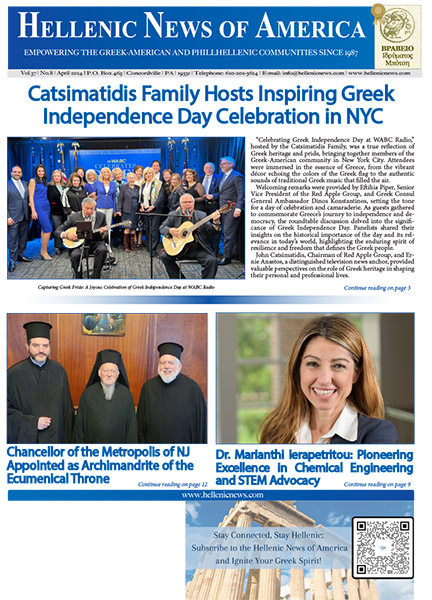By Catherine Tsounis
With the passing of the WWII generation and baby boomers, Greece’s heroism in WWII is not remembered by many, except in our Greek-American schools. Field Marshal Georgy Constantinovich Zhoukov of the Soviet army said “Regardless of what future historians shall say, what we can say now is that Greece gave Mussolini an unforgettable lesson, they were the motive for the revolution in Yugoslavia, they held the Germans in the mainland and Crete for six weeks, they upset the chronological order of all German High Command’s plans and thus brought a general reversal of the entire course of the war, and we won.” 1
Two men separated by over 100 years of history, yet both planted the seeds of their downfall by invading the same country. Possibly the two most significant invasions in modern military history that would significantly change the balance of power in Europe. Napoleon Bonaparte, a man that would change European history forever with not only his military skill, but with the ideas of the French revolution spread across the continent. And Adolf Hitler, possibly one of history’s most horrific ruler whose ambition dragged the world into yet another horrifying war that saw the death of over 50 million people worldwide.2
I was in Red Square on a Sunday, listening to Byzantine liturgical music filling the atmosphere, with Russian Orthodox priests, theology students and military soldiers walking with pride up and down. Yes! The former largest atheistic country now celebrates their religious faith with an intense devotion. This threw me completely off balance, as an America, with two generations of war heroes, who grew up during the “Cold War”. Nearby was the “Museum of the Patriotic War of 1812”, at 2/3 Ploshchad Revolyutsil. I had just read the NY Times Bestseller on “Napoleon the Great” by Andrew Roberts. I was curious to see the Russian outlook on the French invasion of Russia.
The first exhibit showed a gold colored metal statue of Napoleon. The 1812 museum showed the following: maps; official decrees and documents; banners; awards; numismatics; munitions; cannons; French and Russian uniforms of 1812; guns; medals; a field kitchen;, clergy robes; liturgical items; porcelain dishes: crosses; icons and oil paintings of historical 1812 events. Busts of the Bonaparte family were prominently displayed in the center of the hall. In the introductory zone of the museum, the film 1812, produced by The Foundation for Support of Culture, Art and Education, brought the exhibits alive. A manifesto of Emperor Alexander I about the defense of the country and the creation of local militias was described.
“In an exhibit on the eve of the Battle of Borodino, the icon of Our Lady of Smolensk was carried around the Russian positions to encourage the soldiers and to boost their morale before the general engagement. On the day of the Battle of Borodino, processions of three icons, Hodegetria of Smolensk, Our Lady of Vladimir and the Iveron Theotokos were carried around Bely Gorod, Kitai-Gorod and the Kremlin walls. This exhibit and video of the icon procession brought alive my Greek-American education at St. Demetrios Church in Astoria and our daughter’s education at St. Nicholas Church in Flushing, New York. It was a thousand years ago, Greeks paraded icons in front of the invaders. A long time ago, unrelated to the modern ages. To see a video in September 2015 of thousands of troops, mostly serfs (agricultural laborers bound under the feudal system to work on their lord’s estate), standing in respect and praying in front of icons, created by former atheistic, communist media personnel, amazed me and my companions!
The Byzantines accorded icons extraordinary, even miraculous powers to answer prayers, heal the sick, and provide protection. They were worshipped at home and in church, and were carried in public processions along streets and into battle. In 626 an icon of Christ was credited with saving Constantinople from a Persian assault. On the eve of the fall of Constantinople to the Ottomans in 1453, the patriarch paraded a precious icon around the city walls in a last effort to prevent the inevitable collapse of what little then remained of the Byzantine Empire.3 It’s a comfort to know one’s roots live on in 2015.
The oil paintings of that era got its point across. A troubled Napoleon is seen resting at a village church, in his retreat from Moscow. An oil portrait of the regimental priest, Protoiereus Vasily Sitcilinsky shows him with the medal from the Order of Saint Anna of the second degree with the Order of Saint Vladimir of the third degree. A burning Moscow and execution of arsonists shows a city in collapse.
A wall painting of “Saint Blessed Prince Alexander Nevsky Receives Papal Legates” is displayed from the Church of the Savior Cathedral that was built in honor of the 1812 war. It describes the 1251 event when a group of cardinals with a papal bull arrived at Veliky Novgorod, the birthplace of the Russian nation. If Prince Nevsky converted to Catholicism, the Teutonic Knight would help defend Rus (early Russia) from the Tartars. Faithfull to his forefather’s legacy, Alexander Nevsky rejected the ambassadors. This Cathedral was demolished by Stalin. It became the largest open air swimming pool in the world. In 2000, the Church of the Savior Cathedral was rebuilt on blueprints of the original design. Two emperors, Alexander1 and Napoleon, are in the center of political and military events, making it a memorable visit. https://www.qgazette.com/news/2014-07-30/Features/2014_Zoullas_Lecture_Series_Focuses_On_Greeces_Her.html






